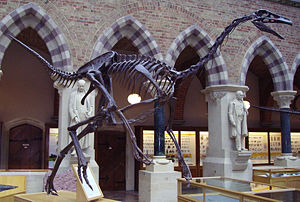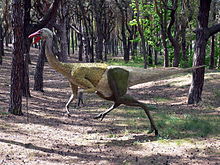Ornithomimidae
| Ornithomimidae | ||||||||||||
|---|---|---|---|---|---|---|---|---|---|---|---|---|

Skeleton of Struthiomimus |
||||||||||||
| Temporal occurrence | ||||||||||||
| Upper chalk ( Turonium to Maastrichtium ) | ||||||||||||
| 93.9 to 66 million years | ||||||||||||
| Locations | ||||||||||||
|
||||||||||||
| Systematics | ||||||||||||
|
||||||||||||
| Scientific name | ||||||||||||
| Ornithomimidae | ||||||||||||
| Marsh , 1890 |
The Ornithomimidae are a systematic group of dinosaurs within the Ornithomimosauria . They were slim-built animals that could presumably run fast. The toothless beak was characteristic; what they ate with it is controversial. The Ornithomimidae are documented mainly from the Upper Cretaceous from East Asia and western North America.
features
Ornithomimidae were medium-sized representatives of the Theropoda , they reached a length of 3 to 6 meters.
The skull of the Ornithomimidae was elongated and toothless. There was probably a horned beak at the tip of the snout. The head was relatively small and light, the skull and snout region were pneumatized, that is, provided with air-filled cavities. The eyes were very large and attached to the sides of the head, and the brain must also have been well developed.
The forelimbs were relatively large compared to other theropods, but delicately built. The large hands consisted of three fingers, characteristic of this group is that the three metacarpal bones (metacarpus) were approximately the same length. The fingers had blunt claws. The hind legs were longer than the front legs and carried the entire weight - like all Theropoda, the Ornithomimidae only moved biped (with the hind legs). The lower legs were longer than the upper thighs, which is an indication of fast running. The first toe was missing, the three existing toes were pointed symmetrically forward. The metatarsus was narrow and elongated. It also showed the so-called arctometatarsal condition: the third (middle) of the three metatarsal bones was only similarly wide in the lower part of the metatarsal, tapered sharply towards the top and was only involved in the contact area to the tarsal to a small extent.
Fossils of a young animal and two adult specimens from Alberta , around 72 million years old, show that ornithomimus had downy feathering and that the older ones also had longer feathers on their forearms that gave their forelegs an appearance similar to that of a bird's wing. The late development of the long forearm fletching suggests that it may have served as a means of showing off or offered additional protection for the eggs of breeding animals.
Paleobiology
Ornithomimidae were fast runners who could possibly reach the speeds of today's ratites . There are some finds of several animals in the same place, which suggest that they lived together in groups at least at times.
What the animals ate is controversial. Despite belonging to the Theropoda, they were probably not predators, but the weak hands and the eyes attached to the side speak against it. Finds of gastroliths could be an indication of vegetable food; lamellae discovered in Gallimimus's beak are interpreted as a filter device with which they sifted small organisms out of the water. Insects as prey or an omnivorous food have also been suggested.
Systematics
The Ornithomimidae together with some primitive representatives ( Pelecanimimus , Shenzhousaurus and Harpymimus ) and the more cumbersome Deinocheiridae form the Ornithomimosauria . The primitive representatives differ from the Ornithomimidae in some respects: some of them still have teeth, the first toe is still present and the arctometatarsal position of the metatarsal bones is not pronounced.
The following genera are included in the Ornithomimidae:
- Aepyornithomimus
- Anserimimus
- Archaeornithomimus
- Gallimimus
- Ornithomimus (including dromiceiomimus )
- Qiupalong
- Rativates
- Sinornithomimus
- Struthiomimus
Fossils of these animals have been found in East Asia and western North America. All of them come from the Upper Cretaceous ( Turonian to Maastrichtian ) and are therefore 94 to 66 million years old.
literature
- Peter J. Makovicky , Yoshitsugu Kobayashi, Philip J. Currie : Ornithomimosauria. In: David B. Weishampel , Peter Dodson , Halszka Osmólska (eds.): The Dinosauria . 2nd edition. University of California Press, Berkeley CA et al. a. 2004, ISBN 0-520-24209-2 , pp. 137-150.
Web links
Individual evidence
- ^ Gregory S. Paul : The Princeton Field Guide To Dinosaurs. Princeton University Press, Princeton NJ u. a. 2010, ISBN 978-0-691-13720-9 , pp. 112-117, online .
- ↑ Darla K. Zelenitsky, François Therrien, Gregory M. Erickson, Christopher L. DeBuhr, Yoshitsugu Kobayashi, David A. Eberth, Frank Hadfield. Feathered Non-Avian Dinosaurs from North America Provide Insight into Wing Origins. In: Science . Vol. 338, No. 6106, 2012, pp. 510-514, doi: 10.1126 / science.1225376 .
- ↑ Chinzorig Tsogtbaatar, Yoshitsugu Kobayashi, Tsogtbaatar Khishigjav, Philip J. Currie, Mahito Watabe and Barsbold Rinchen. 2017. First Ornithomimid (Theropoda, Ornithomimosauria) from the Upper Cretaceous Djadokhta Formation of Tögrögiin Shiree, Mongolia. Scientific Reports. 7, Article number: 5835. DOI: 10.1038 / s41598-017-05272-6
- ↑ Li Xu, Yoshitsugu Kobayashi, Junchang Lü, Yuong-Nam Lee, Yongqing Liu, Kohei Tanaka, Xingliao Zhang, Songhai Jia and Jiming Zhang: A new ornithomimid dinosaur with North American affinities from the Late Cretaceous Qiupa Formation in Henan Province of China . In: Cretaceous Research . 32, No. 2, 2011, pp. 213-222. doi : 10.1016 / j.cretres.2010.12.004 .
- ↑ Bradley McFeeters, Michael J. Ryan, Claudia Schröder-Adams and Thomas M. Cullen. 2016. A New Ornithomimid Theropod from the Dinosaur Park Formation of Alberta, Canada. Journal of Vertebrate Paleontology. doi: 10.1080 / 02724634.2016.1221415 .

